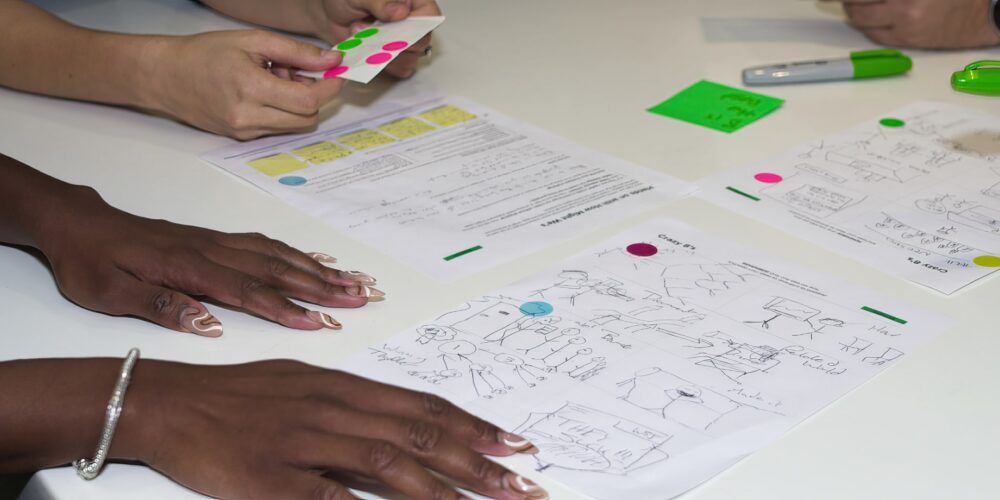
Kickstarting Your Design Sprint: The Power of Generative Research
Generative Research Could Be the Key to Supercharging Your Design Sprint
Design sprints are a proven way to rapidly and effectively solve complex problems and create innovative solutions. Developed originally at Google Ventures, design sprints are a structured, 5-day focused process where cross-functional teams collaborate to conceive, prototype and test solutions with real customers.
Running design sprints is a core function of Three Five Two (and one of our favorite things to do!). We’ve run design sprints for years, with companies ranging from nimble startups to heavyweight Fortune 500 companies, but no matter the company size or makeup, we’ve seen firsthand that it can be hard to know where to start.
Sure, we have companies come to us with a super well-defined problem, looking to use a design sprint to rapidly ideate and develop a proof-of-concept to test with customers and show executive leaders at their company. But, more often than not, the starting line is much fuzzier. Raise your hand if you’ve ever been handed down high level, sometimes even vague, company objectives to ‘increase revenue’ or ‘future proof’ the company. You’re not alone! We’ve seen plenty of clients with those kinds of directives who need help figuring out how and where to start. Or they are facing a complicated challenge, like scaling the service or experience part of their business. Or they are noticing some key metrics are off, either with their business or current product, but they can’t quite figure out where or how to fix it.
If any of these situations sound familiar to you, you could benefit from conducting generative research before your sprint.
Generative research: a pre-sprint powerhouse
Generative research is the initial phase of the design process that involves exploring and understanding the problem space. Unlike evaluative research, which assesses existing solutions, sizing what’s already out there, generative research is your Sherlock Holmes — all about careful analysis to unlock new discoveries. Its primary purpose is to uncover new insights, opportunities, and pain points. This research phase can include activities like user interviews, surveys, field studies, and good old competitive sleuthing, amongst others.
Now that we understand what generative research is, let’s explore some of the ways you can leverage this type of research to help you find focus and get more out of your sprint. With generative research you can…
Understand the Problem Space
Design sprints are often undertaken to find innovative solutions to complex problems. Generative research is all about understanding the problem space, which is the foundation for designing effective solutions. By conducting generative research, you can identify and define the problem you’re trying to solve more precisely. This research phase allows you to gather insights into your users, their pain points, and their needs. Without a strong understanding of the problem space, any solutions generated in the sprint may miss the mark.
Align Stakeholders
Design sprints often (and should!) involve cross-functional teams with divergent points of view. Naturally, these teams sometimes have varying opinions and objectives. Generative research can serve as a unifying force, helping teams to align their understanding of the problem and the users. Think of it as a pre-design sprint team retreat (minus the awkward trust falls) to set the stage and create a unifying force. This alignment is critical for a successful design sprint, as it ensures everyone is on the same page and working toward a common goal.
Inform Future Ideation
One of the primary activities in a design sprint is ideation. With generative research, your team goes into the sprint with a wealth of insights and data about user needs and pain points. This information acts as a rich source of inspiration for generating creative ideas that are aligned with user expectations and rooted in real user needs.
Find Inspiration from Diverse Sources
Generative research can expand your perspective by examining existing solutions, best practices, and competitive products. This broad view can inspire new ideas and directions for your design sprint.
Build Empathy and Create User-Centric Solutions
Empathy is at the core of successful design. Generative research allows you to connect with your users on a deeper level, helping you understand their pain points, motivations, and behaviors. This empathy is essential for designing products that resonate with and genuinely serve your audience. When you intimately understand your users, your design sprint activities will be more meaningful and user-focused. This translates into more user-friendly, intuitive, and effective solutions. When users see their needs addressed in the final product, it increases the chances of a successful launch and positive reception.
Prioritize and Focus
One of the main benefits of generative research is that it helps you prioritize your design efforts. You can’t address every issue at the same time in one design sprint, and not all problems and needs are created equal. Generative research enables you to identify the most critical issues and clear away competing distractions. With your newfound insight, you can focus your design sprint on solving the most pressing challenges, making the most efficient use of your limited time and resources.
Reduce Wasted Effort and Reduce Risk
Design sprints are intensive and time-consuming, and investing resources in a solution that hasn’t been thoroughly validated can be costly. One of the main advantages of generative research is that it helps in preventing wasted effort. By starting with solid research, you can prioritize and validate ideas, ensuring that the design sprint’s focus remains on concepts that are more likely to succeed. By vetting ideas early on, you can focus your sprint on the real contenders, saving time, effort, and the occasional “back to the drawing board” moment. This approach not only saves time and resources but also boosts the confidence of the design team and stakeholders in the final product.
One more thing…
And one more hot tip about using generative research to set the stage for your design sprint: the power of turning those generative research insights into Point of View Statements. Tools like this help you to turn your findings into meaningful stories and generate salient hypotheses. From there, you can use these hypotheses to focus your design sprint with ease.
Generative research isn’t just a warm-up act; it’s a strategic foundation that can amplify the effectiveness of a design sprint. It guides the process towards solutions that are not only innovative but also deeply aligned with user needs and business goals. It directs your creative energies where they’re needed most, ensuring that the end result not only wows but also works wonders for your users and business.




